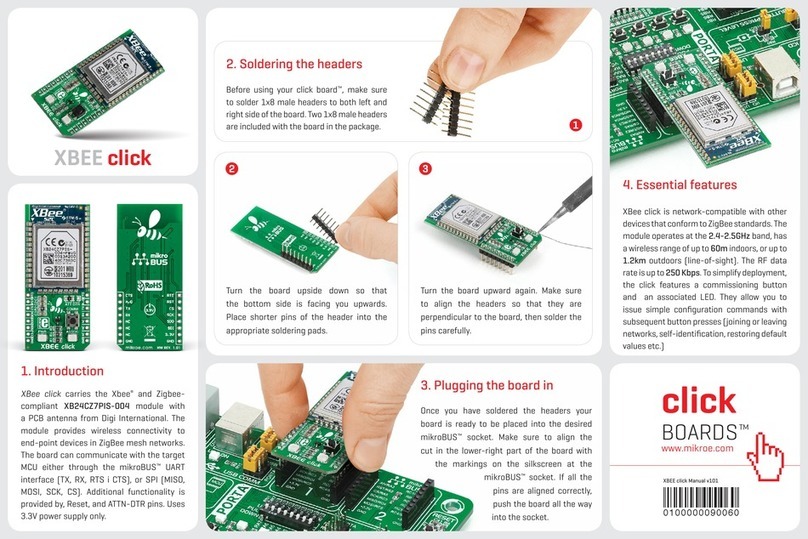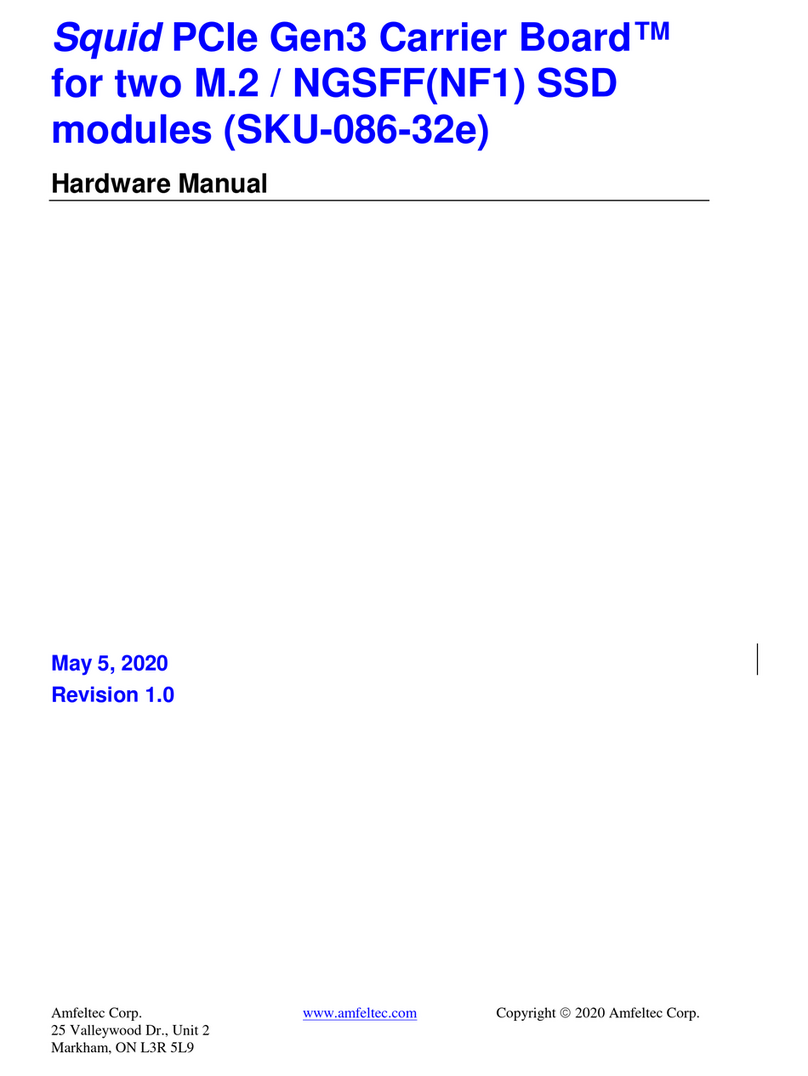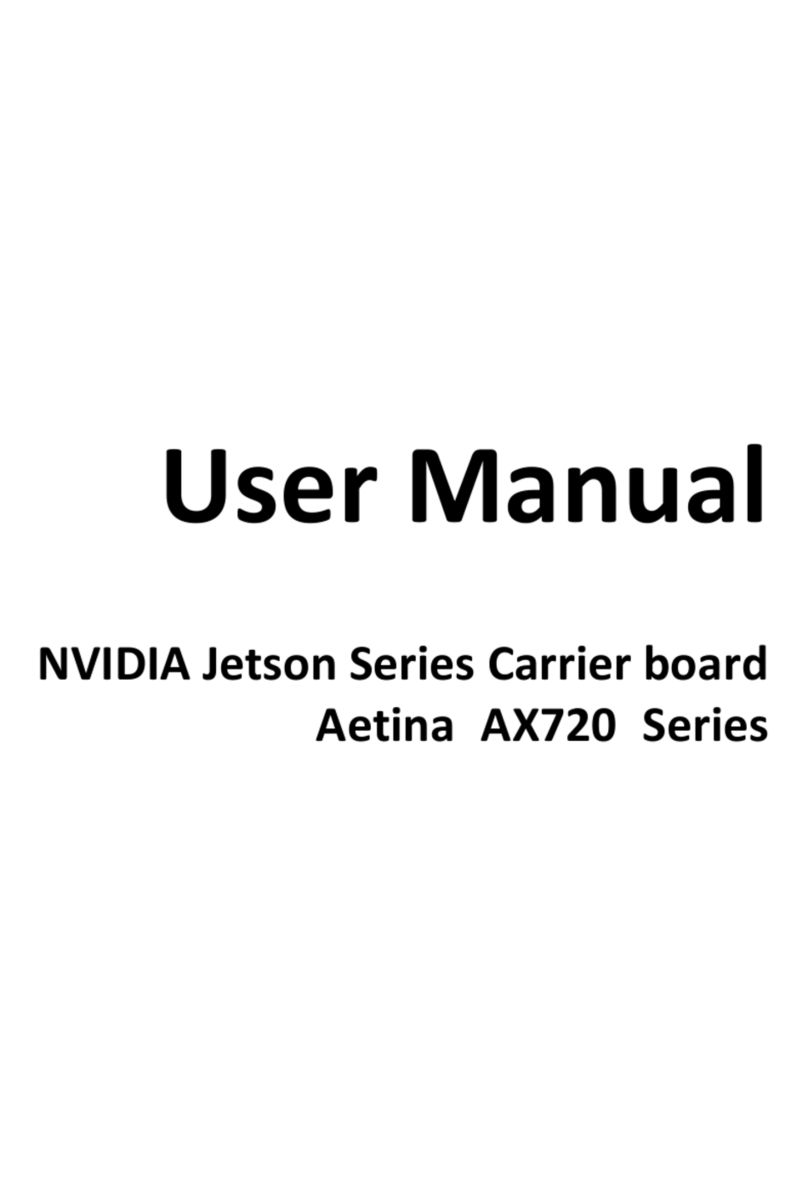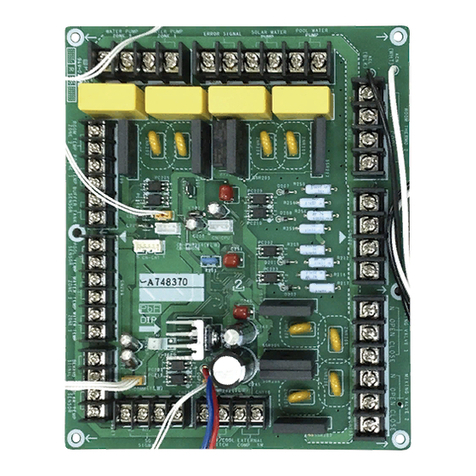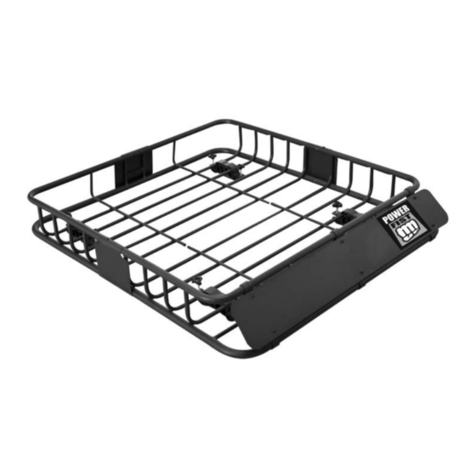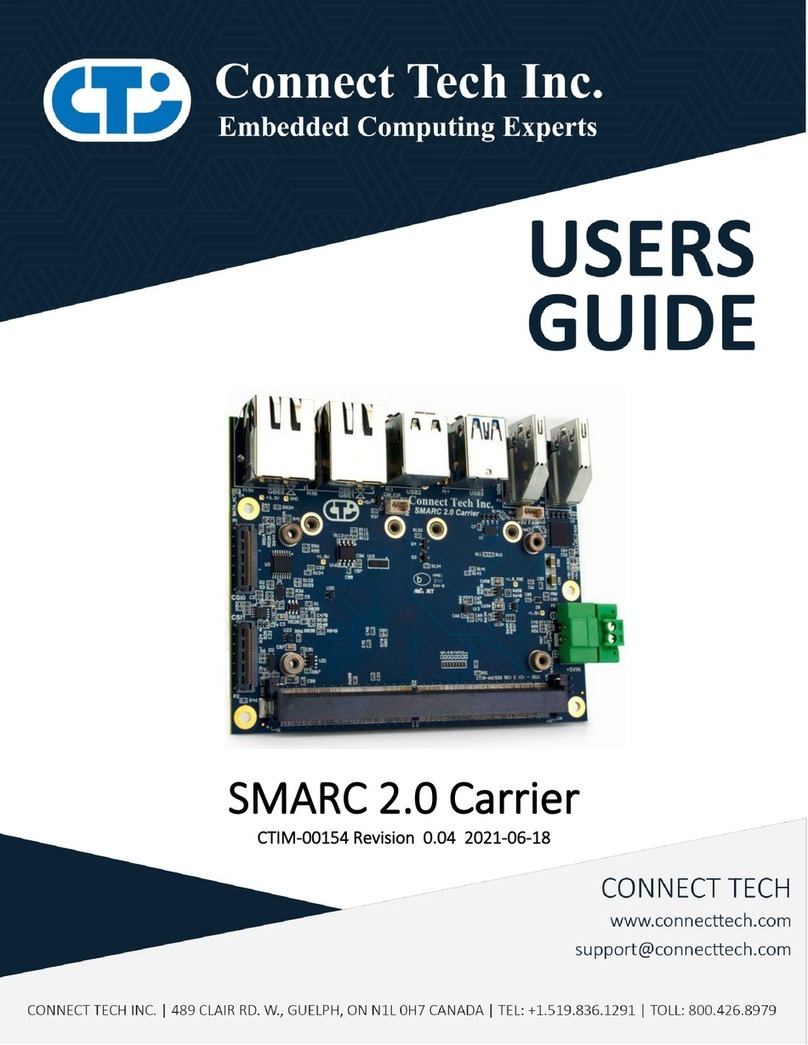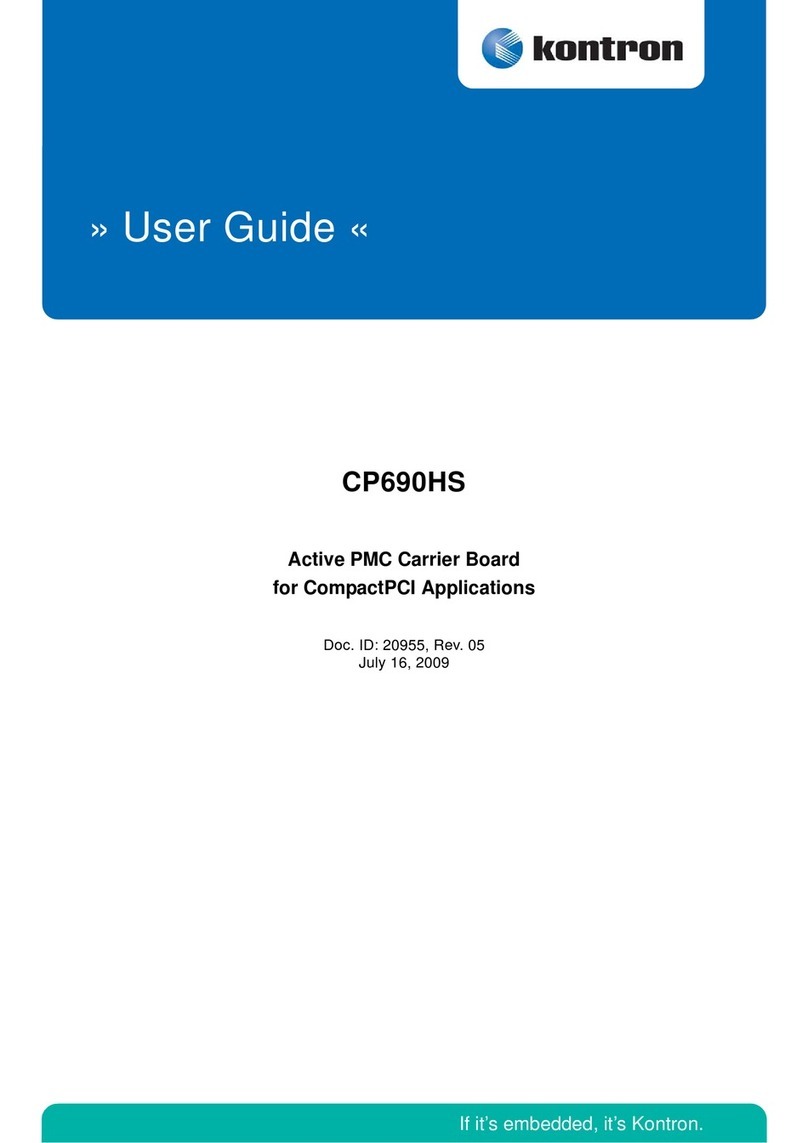MEN G212 User manual

User Manual
G212
PCIe MiniCard Carrier for Wireless Functions
3U CompactPCI Serial
2016-05-1920G212-00 E3

20G212-00 E3 2016-05-19 Page 2
G212 – PCIe MiniCard Carrier for Wireless Functions
G212 – PCIe MiniCard Carrier for Wireless Functions
CompactPCI Serial Carrier Board
The G212 is a rugged single Eurocard CompactPCI Serial carrier board supporting the PCI
Express MiniCard standard or, as an option, the ExpressCard standard. ExpressCard is
the successor of the CardBus standard and offers different construction sizes as well as
connection via PCI Express or USB 2.0.
Supports Various Standards for Wireless Communication
The standard version of the G212 offers two PCI Express MiniCard slots. It allows the use
of all types of cards for high frequency applications like, for example GPS, WLAN, UMTS,
GSM, or HSDPA. Each card is connected to two robust redundant external SMA antenna
connectors at the front panel of the G212.
Using these standard cards that provide access to the whole world of common notebook
PC expansions, is also a fast and easy way to extend the functionality of a CompactPCI
Serial system.
Designed for Use in Harsh and Mobile Environments
The G212 is designed for -40 to +85°C operating temperature and prepared for
conformal coating in order to be used also in harsh and mobile environments. The final
environmental qualification depends on the respective cards used on the carrier.

20G212-00 E3 2016-05-19 Page 3
Diagram
Diagram
USBHub
PCIex1
PCIeMiniCard
Slot1(J2)
B
PCIex1
PCIExpressSwitch
P1
R
FFront RearRB Onboard Options
PCIex1
USB2.0
USB2.0
USB2.0
PCIex1
ExpressCard
Slot1(J4) B
PCIex1
ExpressCard
Slot2(J5) B
USB2.0
USB2.0
CLK
SIMCard
Slot(P2) B
SIMCard
Slot(P3) B
SMAantenna
SMAantenna
SMAantenna
F
F
SMAantenna
F
F
PCIeMiniCard
Slot2(J3)
B
USB2.0
F
USB2.0
F
USB2.0
F
USB2.0
F
PSU +12V
SMB+GA
IOExpander

20G212-00 E3 2016-05-19 Page 4
Technical Data
Technical Data
Card Interfaces
Two PCI Express MiniCards (only full size) or
Two ExpressCard/34 modules
One ExpressCard/54 module
SIM card holder
USB and PCI Express interface
Please note that MEN does not offer SIM cards or mobile telephony contracts!
Front Connections
Four Reverse SMA antenna connectors
Optional 4 USB 2.0 connectors
CompactPCI Serial
Compliance with CompactPCI Serial PICMG CPCI-S.0 Specification
Peripheral slot
Host interface: one PCI Express x1 link and a differential pair of USB lines
-PCIe 1.1: Data rate up to 250 MB/s in each direction (2.5 Gbit/s per lane)
-USB 2.0: Data rate up to 480 Mbit/s
Electrical Specifications
Supply voltage/power consumption:
-+12V (-10%/+10%), depending on plugged card, 0.1A max. w/o card
Mechanical Specifications
Dimensions: conforming to CompactPCI Serial specification for 3U boards
Front panel: 4 HP or 8 HP with ejector
Weight: 134 g (without cards)
See the MEN website for configuration options.

20G212-00 E3 2016-05-19 Page 5
Technical Data
Environmental Specifications
Temperature range (operation):
--40 to +85°C (screened, only carrier, depending on configuration)
-Airflow: min. 1.0 m/s
Temperature range (storage): -40 to +85°C
Relative humidity (operation): max. 95% non-condensing
Relative humidity (storage): max. 95% non-condensing
Altitude: -300m to + 3,000m
Shock: 15g/11ms
Bump: 10g/16ms
Vibration (sinusoidal): 1g/10..150Hz
Conformal coating on request
MTBF
MTBF: 2,534,034h @ 40°C according to IEC/TR 62380 (RDF 2000)
Safety
PCB manufactured with a flammability rating of 94V-0 by UL recognized
manufacturers
EMC
Conforming to EN 55022 (radio disturbance), IEC1000-4-2 (ESD) and IEC1000-4-4
(burst)
Software Support
PCIe MiniCard and ExpressCard drivers as supported
See the MEN website for more information on supported operating
system versions and drivers.

20G212-00 E3 2016-05-19 Page 6
Product Safety
Product Safety
Electrostatic Discharge (ESD)
Computer boards and components contain electrostatic sensitive devices.
Electrostatic discharge (ESD) can damage components. To protect the PCB
and other components against damage from static electricity, you should
follow some precautions whenever you work on your computer.
Power down and unplug your computer system when working on the
inside.
Hold components by the edges and try not to touch the IC chips, leads,
or circuitry.
Use a grounded wrist strap before handling computer components.
Place components on a grounded antistatic pad or on the bag that came
with the component whenever the components are separated from the
system.
Only store the product in its original ESD-protected packaging. Retain
the original packaging in case you need to return the product to MEN for
repair.

20G212-00 E3 2016-05-19 Page 7
About this Document
About this Document
This user manual is intended only for system developers and integrators, it is not
intended for end users.
It describes the design, functions and connection of the product. The manual does not
include detailed information on individual components (data sheets etc.).
History
G212 product page with up-to-date information and downloads:
www.men.de/products/g212/
Issue Comments Date
E1 First issue 2010-05-10
E2 Added SMBus Functionality chapter.
Fixed pin assignment tables for PCI Express Mini Card
2014-01-16
E3 General update, SMBus chapter changed, updated pin
assignment tables for PCI Express Mini Card.
2016-05-19

20G212-00 E3 2016-05-19 Page 8
About this Document
Conventions
Indicates important information or warnings concerning situations which
could result in personal injury, or damage or destruction of the
component.
Indicates important information or warnings concerning the use of
voltages that could lead to a hazardous situation which could result in
personal injury, or damage or destruction of the component.
Indicates important information concerning electrostatic discharge which
could result in damage or destruction of the component.
Indicates important information or warnings concerning proper
functionality of the product described in this document.
The globe icon indicates a hyperlink that links directly to the Internet.
When no globe icon is present, the hyperlink links to specific information
within this document.
Italics Folder, file and function names are printed in italics.
Mono A monospaced font type is used for hexadecimal numbers, listings, C
function descriptions or wherever appropriate. Hexadecimal numbers are
preceded by "0x".
Comment Comments embedded into coding examples are shown in green text.
IRQ#
/IRQ
Signal names followed by a hashtag "#" or preceded by a forward slash "/"
indicate that this signal is either active low or that it becomes active at a
falling edge.
In/Out Signal directions in signal mnemonics tables generally refer to the
corresponding board or component, "in" meaning "to the board or
component", "out" meaning "from the board or component".

20G212-00 E3 2016-05-19 Page 9
Legal Information
Legal Information
Changes
MEN Mikro Elektronik GmbH ("MEN") reserves the right to make changes without further
notice to any products herein.
Warranty, Guarantee, Liability
MEN makes no warranty, representation or guarantee of any kind regarding the
suitability of its products for any particular purpose, nor does MEN assume any liability
arising out of the application or use of any product or circuit, and specifically disclaims
any and all liability, including, without limitation, consequential or incidental damages.
TO THE EXTENT APPLICABLE, SPECIFICALLY EXCLUDED ARE ANY IMPLIED WARRANTIES
ARISING BY OPERATION OF LAW, CUSTOM OR USAGE, INCLUDING WITHOUT LIMITATION,
THE IMPLIED WARRANTIES OF MERCHANTABILITY AND FITNESS FOR A PARTICULAR
PURPOSE OR USE. In no event shall MEN be liable for more than the contract price for
the products in question. If buyer does not notify MEN in writing within the foregoing
warranty period, MEN shall have no liability or obligation to buyer hereunder.
The publication is provided on the terms and understanding that:
1. MEN is not responsible for the results of any actions taken on the basis of
information in the publication, nor for any error in or omission from the publication; and
2. MEN is not engaged in rendering technical or other advice or services.
MEN expressly disclaims all and any liability and responsibility to any person, whether a
reader of the publication or not, in respect of anything, and of the consequences of
anything, done or omitted to be done by any such person in reliance, whether wholly or
partially, on the whole or any part of the contents of the publication.
Conditions for Use, Field of Application
The correct function of MEN products in mission-critical and life-critical applications is
limited to the environmental specification given for each product in the technical user
manual. The correct function of MEN products under extended environmental
conditions is limited to the individual requirement specification and subsequent
validation documents for each product for the applicable use case and has to be agreed
upon in writing by MEN and the customer. Should the customer purchase or use MEN
products for any unintended or unauthorized application, the customer shall indemnify
and hold MEN and its officers, employees, subsidiaries, affiliates, and distributors
harmless against all claims, costs, damages, and expenses, and reasonable attorney fees
arising out of, directly or indirectly, any claim or personal injury or death associated with
such unintended or unauthorized use, even if such claim alleges that MEN was negligent
regarding the design or manufacture of the part. In no case is MEN liable for the correct
function of the technical installation where MEN products are a part of.
Qualified Personnel
The product/system described in this documentation may be operated only by
personnel qualified for the specific task in accordance with the relevant documentation,
in particular its warning notices and safety instructions. Qualified personnel are those
who, based on their training and experience, are capable of identifying risks and
avoiding potential hazards when working with these products/systems.

20G212-00 E3 2016-05-19 Page 10
Legal Information
Conformity
MEN products are no ready-made products for end users. They are tested according to
the standards given in the Technical Data and thus enable you to achieve certification of
the product according to the standards applicable in your field of application.
RoHS
Since July 1, 2006 all MEN standard products comply with RoHS legislation.
Since January 2005 the SMD and manual soldering processes at MEN have already been
completely lead-free. Between June 2004 and June 30, 2006 MEN’s selected component
suppliers have changed delivery to RoHS-compliant parts. During this period any change
and status was traceable through the MEN ERP system and the boards gradually became
RoHS-compliant.
WEEE Application
Nevertheless, MEN is registered as a manufacturer in Germany. The registration number
can be provided on request.
Copyright © 2016 MEN Mikro Elektronik GmbH. All rights reserved.
The WEEE directive does not apply to fixed industrial plants and tools. The
compliance is the responsibility of the company which puts the product on
the market, as defined in the directive; components and sub-assemblies
are not subject to product compliance.
In other words: Since MEN does not deliver ready-made products to end
users, the WEEE directive is not applicable for MEN. Users are
nevertheless recommended to properly recycle all electronic boards which
have passed their life cycle.
Germany
MEN Mikro Elektronik GmbH
Neuwieder Straße 3-7
90411 Nuremberg
Phone +49-911-99 33 5-0
France
MEN Mikro Elektronik SAS
18, rue René Cassin
ZA de la Châtelaine
74240 Gaillard
Phone +33-450-955-312
USA
MEN Micro Inc.
860 Penllyn Blue Bell Pike
Blue Bell, PA 19422
Phone 215-542-9575
China
MEN Mikro Elektronik
(Shanghai) Co., Ltd.
Room 808-809, Jiaxing
Mansion, No. 877 Dongfang
Road
200122 Shanghai
Phone +86-21-5058-0961
www.men.de
www.men-france.fr
sales@menmicro.com
www.menmicro.com
sales@men-china.cn
www.men-china.cn

20G212-00 E3 2016-05-19 Page 11
Contents
Contents
1 Getting Started . . . . . . . . . . . . . . . . . . . . . . . . . . . . . . . . . . . . . . . . . . . . . . . . 13
1.1 Map of the Board . . . . . . . . . . . . . . . . . . . . . . . . . . . . . . . . . . . . . . . . . . . . . . . . .13
1.2 Configuring the Hardware . . . . . . . . . . . . . . . . . . . . . . . . . . . . . . . . . . . . . . . . . .14
1.3 Integrating the Board into a System . . . . . . . . . . . . . . . . . . . . . . . . . . . . . . . . .14
1.4 Installing Driver Software . . . . . . . . . . . . . . . . . . . . . . . . . . . . . . . . . . . . . . . . . . 15
2 Functional Description. . . . . . . . . . . . . . . . . . . . . . . . . . . . . . . . . . . . . . . . . . 16
2.1 Power Supply. . . . . . . . . . . . . . . . . . . . . . . . . . . . . . . . . . . . . . . . . . . . . . . . . . . . .16
2.2 PCI Express MiniCard Interface. . . . . . . . . . . . . . . . . . . . . . . . . . . . . . . . . . . . . .16
2.2.1 PCI Express MiniCard Connector Pin Assignment . . . . . . . . . . . . . .17
2.2.2 Installing a PCI Express MiniCard. . . . . . . . . . . . . . . . . . . . . . . . . . . .19
2.3 ExpressCard Interface (Optional) . . . . . . . . . . . . . . . . . . . . . . . . . . . . . . . . . . . .20
2.4 SIM Card Holder . . . . . . . . . . . . . . . . . . . . . . . . . . . . . . . . . . . . . . . . . . . . . . . . . .22
2.5 SMBus Functionality . . . . . . . . . . . . . . . . . . . . . . . . . . . . . . . . . . . . . . . . . . . . . . .23
2.6 CompactPCI Serial Interface . . . . . . . . . . . . . . . . . . . . . . . . . . . . . . . . . . . . . . . .24
3 Appendix. . . . . . . . . . . . . . . . . . . . . . . . . . . . . . . . . . . . . . . . . . . . . . . . . . . . . . 25
3.1 Product Identification. . . . . . . . . . . . . . . . . . . . . . . . . . . . . . . . . . . . . . . . . . . . . .25

20G212-00 E3 2016-05-19 Page 12
Figures
Figure 1. Map of the board – front panel . . . . . . . . . . . . . . . . . . . . . . . . . . . . . . . . . . . . . .13
Figure 2. Map of the board – top view. . . . . . . . . . . . . . . . . . . . . . . . . . . . . . . . . . . . . . . . .14
Figure 3. Installing PCI Express MiniCard . . . . . . . . . . . . . . . . . . . . . . . . . . . . . . . . . . . . . . 19
Figure 4. Position of SIM card holder . . . . . . . . . . . . . . . . . . . . . . . . . . . . . . . . . . . . . . . . .22
Figure 5. Product labels. . . . . . . . . . . . . . . . . . . . . . . . . . . . . . . . . . . . . . . . . . . . . . . . . . . . .25
Tables
Table 1. Pin assignment of 52-pin PCI Express Mini Card connector . . . . . . . . . . . . . .19
Table 2. Signal mnemonics of 52-pin PCI Express Mini Card connector. . . . . . . . . . . . 20
Table 3. Signal mnemonics of 26-pin ExpressCard connector . . . . . . . . . . . . . . . . . . . .22
Table 4. Position of hex switch for setting the SMBus address . . . . . . . . . . . . . . . . . . .25
Table 5. Pin assignment of CompactPCI Serial P1 connector. . . . . . . . . . . . . . . . . . . . .26

Getting Started
20G212-00 E3 2016-05-19 Page 14
Figure 2. Map of the board – top view
1.2 Configuring the Hardware
You should check your hardware requirements before installing the board in a system,
since most modifications are difficult, or even impossible, to do once the board is
mounted in a rack.
The following chapters provide an overview on configuration possibilities.
1.3 Integrating the Board into a System
Use the following "check list" when installing the G212 in a CompactPCI Serial system for
the first time.
»Power-down the system.
»Install one or two PCI Express MiniCards (or optionally ExpressCards) on the G212.
»Insert the G212 into a peripheral slot of your CompactPCI Serial system, making
sure that the CompactPCI Serial connectors are properly aligned.
»Power-up the system.
»You can now install driver software.
P1
Antenna
Connectors
SIMCardHolders
PCIExpressMiniCard
Slot1
ExpressCardSlot1
(Option)
PCIExpressMiniCard
Slot2
ExpressCardSlot2
(Option)
4USBFront
Connectors
(Option)
CoaxialCables
See Chapter 2.2.2 Installing a PCI Express MiniCardfor more information.
The peripheral slots of every CompactPCI Serial system are marked by
a circle on the backplane and/or at the front panel.

Getting Started
20G212-00 E3 2016-05-19 Page 15
1.4 Installing Driver Software
For a detailed description on how to install driver software, please refer to the respective
documentation of the software package to be installed.
See the MEN website for all available software:
www.men.de/products/g212/#downl

Functional Description
20G212-00 E3 2016-05-19 Page 16
2 Functional Description
The following describes the individual functions of the G212. Detailed information
regarding individual components can be obtained from the data sheets or data books of
the semiconductor manufacturer concerned.
2.1 Power Supply
The G212 is supplied with +12V (-5%/+5%) via CompactPCI Serial connector P1.
2.2 PCI Express MiniCard Interface
PCI Express MiniCards are small form factor PCI Express Cards.
The main differences between an ExpressCard and a PCI Express MiniCard is a smaller
form factor optimized for mobile computing platforms and a card-system
interconnection optimized for communication applications. PCI Express MiniCard cards
also use smaller connectors than standard ExpressCards.
The G212 supports the PCI Express MiniCard Standard but only full-size cards can be
used.
A single PCI Express lane (x1) and a USB connection are supported on the board.
See Figure 2, Map of the board – top view on page 14 for the position of the PCI
Express MiniCard connectors.
See Table 1, Pin assignment of 52-pin PCI Express MiniCard connector on page 17 for
connector pinning and Table 2, Signal mnemonics of 52-pin PCI Express MiniCard
connector on page 18 for signal mnemonics.

Functional Description
20G212-00 E3 2016-05-19 Page 17
2.2.1 PCI Express MiniCard Connector Pin Assignment
The board is equipped with two 52-pin standard PCI Express MiniCard connectors. The
following standard signals are supported (signal directions according to PCI Express
MiniCard Standard):
Table 1. Pin assignment of 52-pin PCI Express MiniCard connector
52 +3.3Vaux 51 reserved
50 GND 49 reserved
48 +1.5V 47 reserved
46 LED_WPAN# 45 reserved
44 LED_WLAN# 43 GND
42 LED_WWAN# 41 +3.3Vaux
40 GND 39 +3.3Vaux
38 USB_D+ 37 GND
36 USB_D- 35 GND
34 GND 33 PETp0
32 SMB_DATA 31 PETn0
30 SMB_CLK 29 GND
28 +1.5V 27 GND
26 GND 25 PERp0
24 +3.3Vaux 23 PERn0
22 PERST# 21 GND
20 W_DISABLE# 19 reserved (UIM_C4)
18 GND 17 reserved (UIM_C8)
16 UIM_VPP 15 GND
14 UIM_RESET 13 REFCLK+
12 UIM_CLK 11 REFCLK+-
10 UIM_DATA 9GND
8 UIM_PWR 7 CLKREQ#
61.5V 5COEX2
4GND 3COEX1
2+3.3Vaux 1 WAKE#
1
2
5152

Functional Description
20G212-00 E3 2016-05-19 Page 18
Table 2. Signal mnemonics of 52-pin PCI Express MiniCard connector
Please refer to the PCI Express MiniCard Specification for further details.
Signal Direction Function
Power GND Ground
+3.3Vaux 3.3V source
1.5V 1.5V source
SIM card UIM_PWR out SIM card power
UIM_DATA in/out SIM card data
UIM_CLK out SIM card clock
UIM_RST out SIM card reset
UIM_VPP not connected
PCI Express REFCLK-/REFCLK+ in PCI Express differential reference
clock
PE_RX+/- out PCI Express receive signals
PE_TX+/- in PCI Express transmit signals
Auxiliary
Signals
CLKREQ# out Clock request
PERST# in Reset for the MiniCard
WAKE# out Wake signal
SMB_CLK in System management bus clock (not
connected)
SMB_DATA in/out System management bus data (not
connected)
USB USB_D- in/out USB line
USB_D+ in/out USB line
Communic
ations -
specific
signals
LED_WWAN# out not connected
LED_WLAN# out not connected
LED_WPAN# out not connected
See the PCI Express MiniCard Electromechanical Specification for more
information.

Functional Description
20G212-00 E3 2016-05-19 Page 19
2.2.2 Installing a PCI Express MiniCard
Perform the following steps to install a PCI Express MiniCard. The required screws are
included in the delivery.
»Insert the PCI Express MiniCard into the card connector at a 30° angle.
»Lower the top end of the card until it sits firmly in the connector, and the mounting
holes are aligned with the screw holes on the G212.
»Secure the PCI Express MiniCard tightly to the G212 using the two screws supplied.
»Connect the antennae to the PCI Express MiniCard.
Figure 3. Installing PCI Express MiniCard
See Figure 2, Map of the board – top view on page 14 for the position of the PCI
Express MiniCard connectors.
PCIe
Mini Card
30°
Card connector

Functional Description
20G212-00 E3 2016-05-19 Page 20
2.3 ExpressCard Interface (Optional)
The G212 supports both standard formats of ExpressCard modules, according to the
ExpressCard standard, and both use the same connector interface:
ExpressCard/34 module which is 34 mm wide, and
ExpressCard/54 module which is 54 mm wide.
A single PCI Express lane (x1) and a USB connection are supported on the board.
The board is equipped with up to two 26-pin standard ExpressCard connectors. The
following standard signals are supported:
Table 3. Signal mnemonics of 26-pin ExpressCard connector
The ExpressCards on the G212 cannot be hot-plugged as they are
mounted behind the front panel.
Pin Signal Direction Function
1GND Power
2
3
USBD-
USBD+
in/out Differential pair of USB lines
4 CPUSB# out USB power detection
5 Reserved
6 Reserved
7 SMBCLK out System management bus clock (not
connected)
8 SMBDATA in/out System management bus data (not
connected)
9
10
+1.5V in Power
11 WAKE# out Wake signal from MiniCard slot
12 +3.3V AUX in Power
13 PERST# in Express card reset
14
15
+3.3V in Power
16 CLKREQ# out Clock request from MiniCard slot
17 CPPE# out PCIe power detection
18
19
REFCLK-
REFCLK+
in PCI Express differential reference clock
20 GND Power
21
22
PERn0,
PERp0
out PCI Express receive signals
23 GND Power
Table of contents

